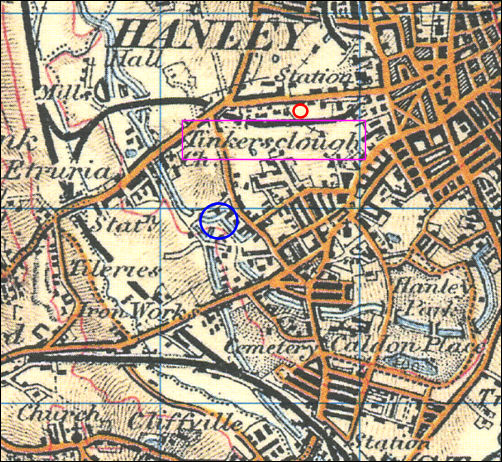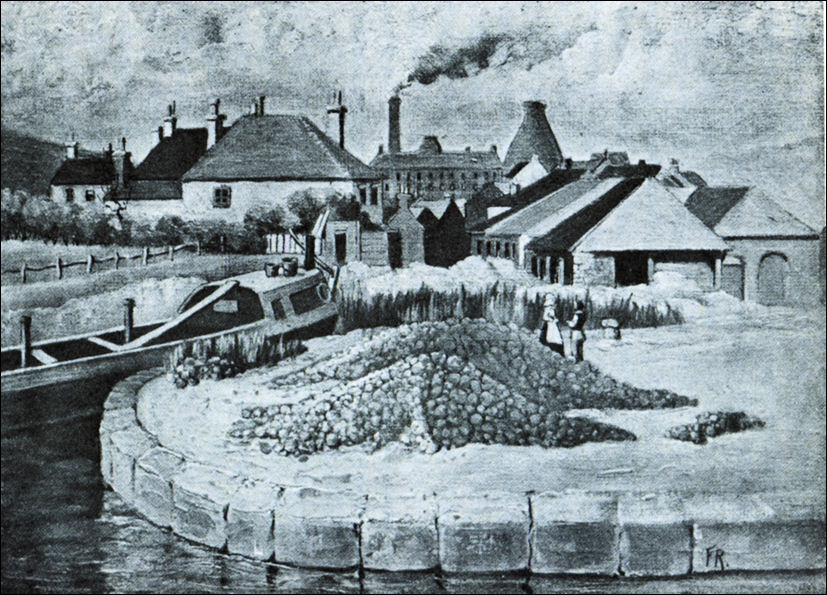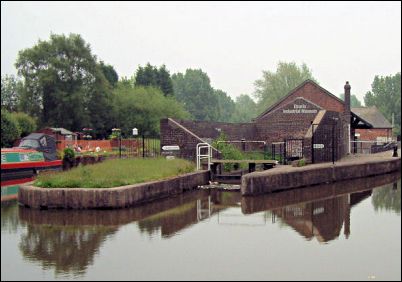![]()
|
|
|
|
|
Stoke-on-Trent - Potworks of the week |
The Toft brothers worked at Tinkersclough, Hanley
The
Tinkersclough area was located in Hanley in the parish of
Stoke-upon-Trent
at the junction of what is now Clough Street and Mount Pleasant.
The Toft family of slipware potters lived and worked here in the latter half of the 17th c.
Some 150 years later, on the location of the Toft works, was built the Dresden Works.
Relevant links:
| Thomas Toft | Tinkersclough | Dresden Works |

Tinkersclough - 1902
|
The thick black line shows the Potteries loop line railway which ran from the mainline at Etruria, through Tinkersclough to Hanley. Running from top left down to bottom centre is the Trent and Mersey canal the Caldon branch canal runs from the Etruria Junction (blue circle) and flows through Hanley Park to the right and onwards to Cheddleton flint mill.
|

"Tinkersclough at the present day"
picture: 1906
"Staffordshire Pots and Potters" - GW & FA Rhead
|
This picture was drawn in 1906 from the the Etruria Basin of the Caldon Canal at Etruria - looking towards Hanley. The building to the centre right were part of the wharf complex and are now part of the Etruria Industrial Museum which opened in 1991. In the middle background is the Dresden Works which stands on the location of the Toft family home and works.
|

Etruria Junction - the Trent
& Mersey & Caldon Canal meet here
photo:
2008
the canal and buildings in the 1906 picture can easily be identified
| Etruria
Junction |

Tinkersclough - 1949
photo: The Warrillow Collection -
Keele University Collection
- the red
circle on the 1902 map above shows the location of the photographer -
|
The light coloured mound at the front of the photo is slag from the Shelton works deposited at Tinkersclough. Towards the bottom right the Rose and Crown can be seen alongside the loop line railway bridge. The back of Wedgwood's Etruria Hall stands almost in the centre, but is not so easy to see in its blackened state. On the horizon can be seen the spire of Wolstanton Church. |
|
"Toft worked at Tinkersclough, which is now a group of a few hundred houses and a couple of potteries. It was formerly a lane, or "clough," about midway between Shelton, Hanley, and Wedgwood's Etruria, and doubtless a convenient resting-place for travelling gipsies and tinkers; hence, probably, its name. It is not positively known whether Toft—Thomas Toft; there were two prominent Tofts, Thomas and Ralph—had a factory of his own, or whether he executed orders for his dishes for other potters.
THOMAS TOFT In the Willett Collection is a large yellow dish with a bird in dull red slip; this is signed " Ralph Toft," and bears the date 1676." "Staffordshire Pots and Potters" -1906 - GW & FA Rhead
NOTE: "This is now generally regarded as a fake foisted upon Solan by hoxers." Makowitz W & Haggar R G (1957) Concise Encyclopedia of English Pottery and Porcelain, André Deutsch Ltd, London p 223
It is believed he was married in 1663 and was buried in Stoke on December 3 1689. Slipware is a kind of coarse earthenware decorated with a coloured clay and water mixture of creamlike consistency called slip.
|
|
Page created 1 Nov 2009 Updated: 9 Sept 2005: Added - introductory paragraph; relevant links; 2008 photo of and link to Etruria junction; Note on hoax "foisted upon Solan"; |